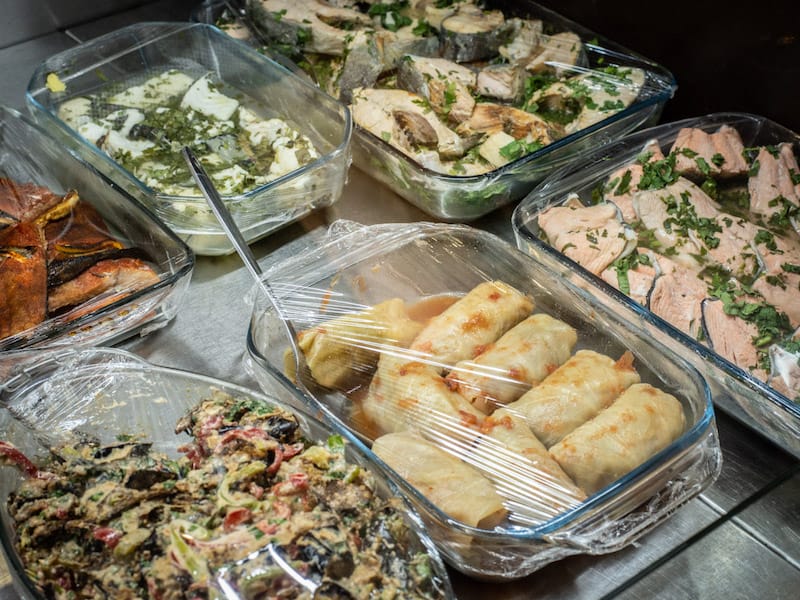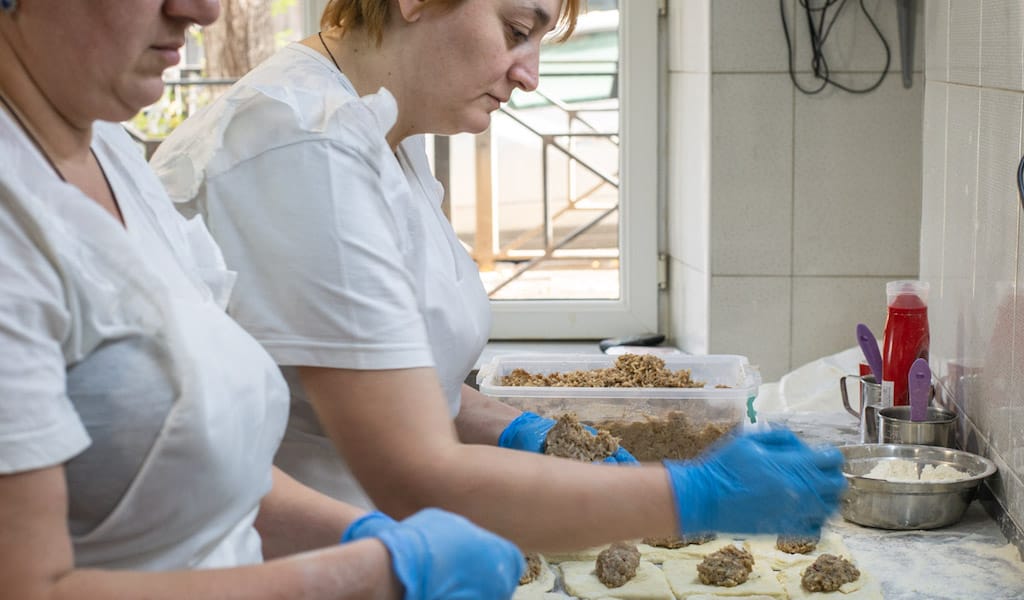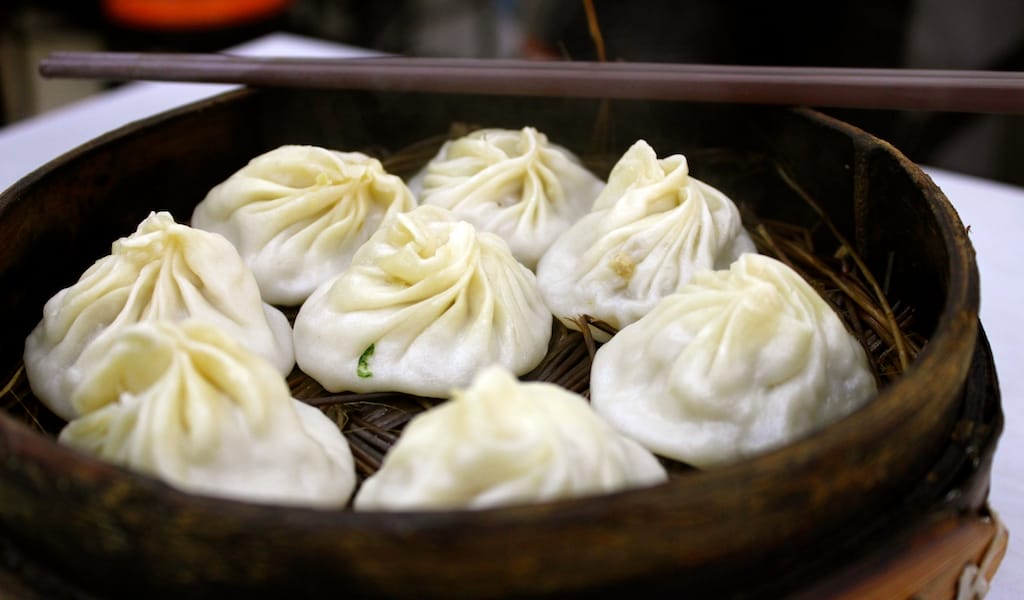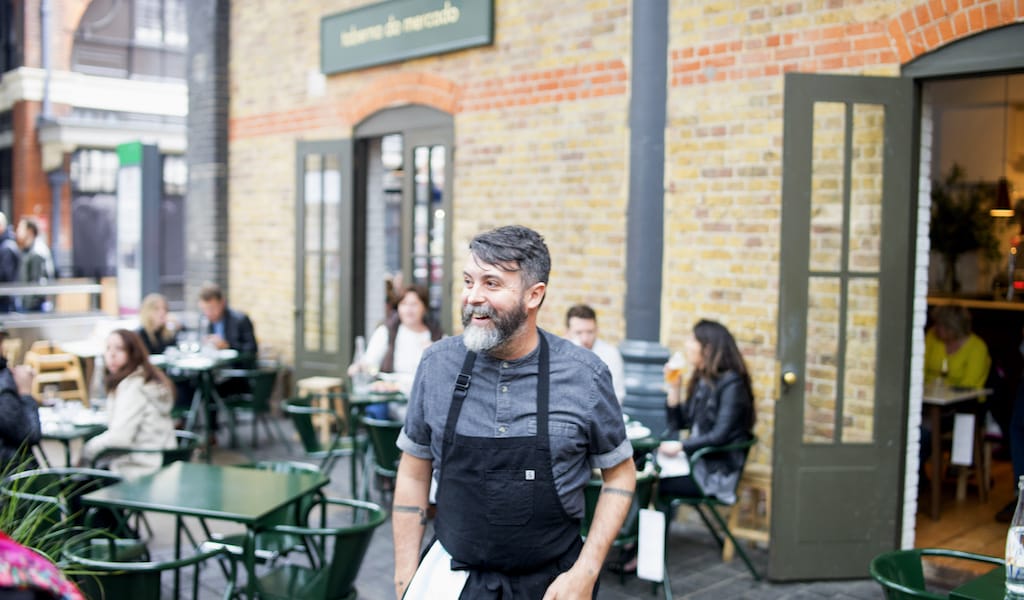You are motionless, stuck in a traffic jam after a long day at work while your stomach growls. You know the rest of the family will be hungry when you get home and that the fridge is empty and sad. Shopping and cooking is out of the question, so you turn onto a Vera side street, zig-zag through one-way lanes to Tatishvili Street, double park, and run into a tiny gastronomic oasis that has been saving lives like yours for nearly a decade. Its name is Tartan.
Located in a step-down ground-floor apartment, takeout cafeterias don’t get homier than this. The front room is taken up with a long counter of refrigerated display cases half filled with enough ready-made dishes to lay down a feast when you get home. The other half offers a diabetic’s nightmare of cake selections that make old cavities ache just browsing through the glass. Two small four-top booths in the corner provide the only seating for those who can’t wait until they get home to eat.
There are other cafeterias in the city that offer pre-cooked meals by weight but Tartan is no mere takeaway. It is a neighborhood institution dedicated to preparing homemade food with a grandmother’s touch, where quality and consistency are taken seriously.

The kitchen is segregated by task throughout the rest of the apartment’s rooms, which are decked out in gleaming stainless steel counters, sinks and shelves – khachapuris and stuffed breads, hot food, salad prep, and storage. Meanwhile, desserts are baked in a separate space across the street.
“We are the customer,” says co-owner Julia Chachiashvili, who also holds a 9-5 office job and has no time to cook, like many of her clients.
Her partners, Nana Zurabashvili and Zaza Tsibadze, manage the daily operations. Fifteen years ago, they opened a neighborhood grocery together. Their winning partnership resulted in Tartan, a busy eatery for working people.
“It is a two-family business,” Julia says proudly. Most of the staff have been here since day one, bringing their own family recipes, some passed down generations on yellowing notepaper, to the menu.
“Everything here is homemade. It is different than what you get at restaurants,” Julia explains.
In fact, some of these grandmother standards are rarely found in Georgian restaurants.
In fact, some of these grandmother standards are rarely found in Georgian restaurants. We have yet to come across anything close to their tender chicken roulade, which is packed with a buttery filling of garlic, onion and red pepper. Dolma are stuffed grape leaves by most standards, but at Tartan they are actually Slavic golubki – cabbage leaves heartily stuffed with meat and rice.
Cabbage also figures in a crispy oil and vinegar coleslaw. Other fresh salads include wooden mushroom with white onion and fresh herbs, and pkhali with ekala – a wild green Tartan freeze-dries to use throughout most of the year. More conventional is the shredded chicken salad, which holds back on the mayo drenching that’s more commonly used.

Cakes and pastries are another Tartan specialty. Georgia is not known for its desserts and few bakeries seem to have the knack of making the kinds of cakes you want to come back for. Powdered milk plays heavily in most pastry kitchens, but Mr. Tsibadze gets fresh milk daily from his neighbor’s cows. It is used for Bird’s Milk cake, a seductively light mousse of whipped sour cream topped in a perfect layer of chocolate. Julia recommends the “Snickers” cake, a toothsome combination of peanuts and chocolate. She blames desserts like these for an extra 10 kilos she didn’t have before opening the cafeteria.
Five bakers work a ten-hour shift to make khachapuri and other stuffed breads like lobiani (bean), mushroom, and tarragon and rice. The layered penovani khachapuri might clog a few arteries, but the way it melts in your mouth is worth the risk of a stroke.
The only problem with Tartan is its own good fortune. Being popular means being busy, and in Tartan’s case that means customers must wait in line. Georgians do not queue well. “Why should I wait behind someone ordering a family meal when all I want is a single khachapuri?” is a refrain we’ve heard here. There is some line jumping but your perseverance will be rewarded, even if all you’re waiting for is an 80-tetri (25-cent) lobiani bun.
The tendency for many entrepreneurs who achieve such success is to expand and be a chain venture, but Julia and her partners are not interested. “Running a place like this is really hard work. It runs smoothly,” she says before greeting a regular customer with a smile. “Why should we over-extend ourselves?”
 June 27, 2022 Take a Bao
June 27, 2022 Take a Bao
Xiaolongbao first appeared around 1875, during the Ming Dynasty, in Nanxiang, a village […] Posted in Shanghai December 27, 2017 CB Book Club
December 27, 2017 CB Book Club
Nuno Mendes is excited. He’s standing at my kitchen counter, where laid out before him […] Posted in Lisbon July 24, 2012 Shanghai: State of the Stomach
July 24, 2012 Shanghai: State of the Stomach
Dining like a local in Shanghai often requires a small leap of faith. You have to forget […] Posted in Shanghai
Published on November 18, 2019
Related stories
June 27, 2022
ShanghaiXiaolongbao first appeared around 1875, during the Ming Dynasty, in Nanxiang, a village on the northwestern outskirts of Shanghai. As the story goes, a vendor selling dry steamed buns decided to innovate due to stiff competition. Legend also suggests, however, that he copied the giant soupier dumplings from Nanjing. Whatever the case, there are several…
December 27, 2017
LisbonNuno Mendes is excited. He’s standing at my kitchen counter, where laid out before him are pieces of half-moon-shaped dough, each encasing a juicy meat mixture. They’re about to go into a pan filled with bubbling oil. My mom, Lica, is nervous. She is sharing her mother’s recipe for pastéis de massa tenra, a traditional…
July 24, 2012
ShanghaiDining like a local in Shanghai often requires a small leap of faith. You have to forget about ambience and brave tough crowds with even tougher elbows to join the raucous, slurping masses with their steamers of the city’s famous soup dumplings, xiǎolóngbāo. Even with its thriving economy and sky-high construction boom, Shanghai still has…



















































































